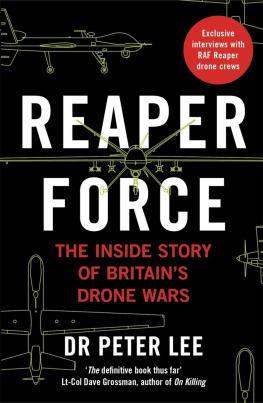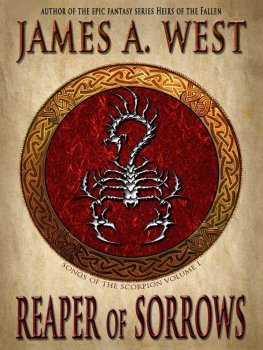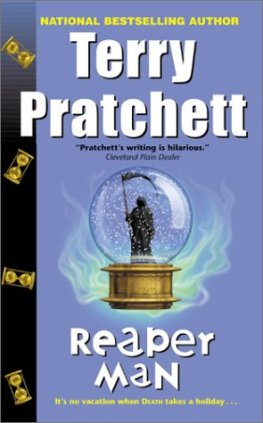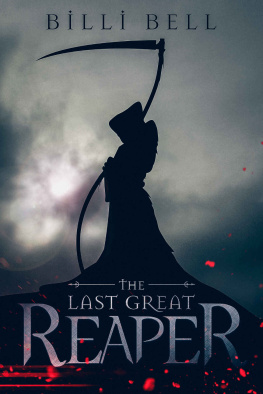The views and opinions expressed in this book are those of the author alone and should not be taken to represent those of Her Majestys Government, MOD, HM Armed Forces or any government agency.
T here are many people who have enabled this book to come to fruition, the majority of whom, for security reasons, cannot be named. I acknowledge you all here.
I begin with my amazing and supportive wife, Lorna, for her unwavering belief in this project and for her practical advice; my daughters, Samantha and Fiona, who are a continuous source of inspiration, laughter and pride; my mother, Sheila, and my late father, Peter, who taught me that life is an adventure to be lived to the full.
From the RAF, the current Air Officer Intelligence, Surveillance, Target Acquisition & Reconnaissance (ISTAR) Force Commander, RAF Waddington. He opened the gates to the Reaper Force for me with infectious enthusiasm, asking only for a fair telling of the Reaper story.
The RAF Waddington Station Commander.
Five current and previous Officers Commanding of 39 and XIII Squadrons, who have not only given me unparalleled, continued access to their facilities and people, but have actively promoted the idea of the Reaper story being told through the experiences of the operators. One Squadron Commander not only took me flying on a day-long live mission, but allowed me to try out the sensor operators (SOs) controls to give me a real understanding of the equipment and the challenges of using it.
The current and previous Director of Defence Studies (RAF) have gone above and beyond in engaging with the Air Staff and the MoD to secure various permissions.
My three official reviewers have been with me from the outset the Director of Defence Studies (RAF), a previous Officer Commanding 39 Squadron and Dr Peter Gray, Senior Fellow in Air Power Studies, University of Birmingham and have also excelled in providing incisive critique and helpful additional detail throughout the book.
My unofficial team of reviewers expanded from an initial core of one active pilot, SO and mission intelligence coordinator (MIC) to include spouses and interested veterans of the Reaper Force I met along the way. They have added detail and context, and helped me with procedures, processes and terminology.
Jeff and Alicia Richard, whose son, US Marine Corporal Matthew T. Richard was killed in action in Afghanistan in 2011, and the US Marines, led by Squad Leader Sergeant Seth Hickman, who helped me to tell Matthews story.
Andrew Lownie, my literary agent, who did so much to help me secure a publisher.
My friends and colleagues at the University of Portsmouth who have provided practical and moral support throughout the project.
My friends and colleagues across the academic drone community, and those from the anti-drone activist community, with whom I have discussed, reasoned and argued over several years, and who have shaped my thinking in the process.
The past and present members of the RAF Reaper Force, and their spouses and partners, who have welcomed me into their community, laughed with me, shed tears with me and entrusted me with their most profound experiences. I promised each of you that I would be honest, accurate and fair, and have strived to match that undertaking at every stage.
Andrew Jeffrey, Joel Anthony, Hayden Hunt and James Robertson for contributing photographs which, with others, are credited in the captions to the photos in the plates section.
Toby Buchan, my editor and great source of encouragement and guidance.
I give you each my profound thanks. This has been the most exciting, moving, challenging and fulfilling project of my life. All of the credit belongs to you and any failings in the pages that follow are mine.
Other photographs are Crown copyright; the link to the licence on the National Archives website can be found at http://www.nationalarchives.gov.uk/doc/open-government-licence/version/3/
9-LINE A series of nine confirmations and checks, and the legal approval, that make up the authorisation to carry out a weapon strike, and includes the location and identity of the target, and the weapon choice
AIRFRAME The structural elements of an aircraft, including the fuselage, wings and undercarriage, but excluding the engine. RAF personnel sometimes use airframe interchangeably with aircraft
AUTH Authorising Officer. Supervises Reaper crews and operations from the Squadron Operations Room
BDA Battle damage assessment
BUDDY LASE When two aircraft and crews work together to strike a target one aircraft fires a laser-guided missile or bomb, while a second uses its laser-guidance system to ensure that the weapon hits the target that the laser is lighting up
CAO Casualty Assistance Officer
CAOC Combined Air Operations Centre
CASEVAC Casualty evacuation
CAT Flying category (e.g. Combat Ready)
CDE Collateral damage estimate
CIVCAS Civilian casualties
CNO Casualty Notification Officer
CRM Crew resource management. The sharing out of responsibilities and tasks between the three crew members
COMMS Communications. Commonly by radio, electronic signal or secure military internet
CPL Corporal
DICKING The observation of military personnel and movements by, usually, low-level, unarmed enemy called dickers (in Afghanistan they would often be young boys). The term was used in Northern Ireland and referred to junior, or would-be, paramilitary members
EOD Explosive Ordinance Disposal
FAST JET A generic British military term that refers to highspeed, jet-propelled, air-to-air fighter aircraft or fighter-bomber aircraft.
FMV Full motion video
FOB Forward Operating Base
GBU Guided Bomb Unit. The Reaper carries two 500lb GBU-12 laser-guided bombs
GCAS Ground close air support
GCS Ground Control Station
HME Home-made explosive
HVT High-value target. For example, an important Taliban figure
IED Improvised explosive device
IN THE BOX In the Ground Control Station, a shipping container-sized metal box
IS Islamic State
ISAF International Security Assistance Force, the NATO-led mission in Afghanistan
ISR Intelligence, surveillance and reconnaissance
ISTAR Intelligence, surveillance, target acquisition and reconnaissance
JTAC Joint Terminal Attack Controller. The person who directs offensive air operations, including close air support, typically from a forward position on the ground or from a Combined Air Operations Centre
KINETIC STRIKE A missile or bomb strike
LASING Using a laser beam to mark or light up a target for a laser-guided missile or bomb strike
LCPL Lance Corporal
LRE Launch and Recovery Element the crew based near the operating area who launch the Reaper and land it at the end of the mission, by remote control. In between take-off and landing, control is transferred electronically so that it is then piloted via satellite link by someone in the UK or USA
MATCH EYES To train the Reaper camera on a target or area that is already being watched by another surveillance aircraft
MCE Mission Control Element











